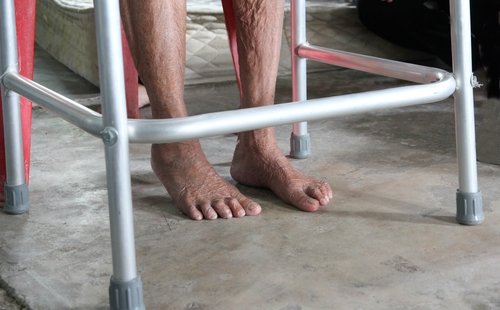Neural stimulation helps stroke, MS patients get back on their feet
ANI May 11, 2017
Stroke and multiple sclerosis (MS) patients can walk significantly better with the neural stimulation, according to a recent study.

Robert Bush has MS, which sapped his ability to walk five years ago. Joseph McGlynn suffered a stroke that seriously impaired his left side, also five years ago.Using technology designed by Case Western Reserve University and the Advanced Platform Technology and Functional Electrical Stimulation centres at the Louis Stokes Cleveland Veterans Affairs Medical Center, the two men got their feet back under them.Two studies show that functional electrical stimulation (FES) significantly helped McGlynn and Bush to effectively walk at the medical centre."I went in there and I could barely take two steps," said Bush, 42, who researchers believe is the world's first MS patient to "test-drive" an implanted FES system. The proof-of-feasibility test lasted 90 days. "At the end," said Bush, of Columbus, Ohio, "I was walking down the hallway. To me, it was monumental."
McGlynn, 69, of North Royalton, Ohio, could walk with a cane, but not easily. With the technology switched on, he covered far more ground and his pace was twice as fast during his 30-week study."It's helped with balance and confidence," said McGlynn, who used to tread a lot of stairs maintaining equipment at a steel plant. "I'm confident now that I can walk without stumbling and falling."
Nathan Makowski, an investigator at the Cleveland FES Center, created by Case Western Reserve and the Cleveland VA, said that FES technology has been used primarily for therapy in stroke patients in the past. "This, though, is a more long-term assistive system," he said.
The researchers hope these studies will lay the foundation for implanted systems that restore some independence to people with MS or who have suffered a stroke.Both men gained strength and endurance through repeated use of the systems and fine-tuning by the researchers.Bush went from the two steps to consistently walking more than 30 yards during the trial. In that time, he used a walker to help maintain his balance."When they turned it on the first time, I was surprised how well it worked," said Bush, who had to give up his construction career due to the disease. "I lifted my knee like I was high-stepping. Once we got it fine-tuned and I got walking, I thought it was amazing. I still think it's amazing."
McGlynn's gait became noticeably more symmetrical and energetic, the researchers said. His gait without the system was about 19 yards per minute; with the system, 47 yards per minute. Training with the system improved McGlynn's speed when it was turned off to 23 yards per minute, indicating therapeutic benefit."Distance is a challenge," he said. Initially, he could walk 83 yards but improved to 1,550 yards at the faster gait. "I work up a good sweat and that makes me feel good," he said.Due to his improvements, the research team is developing a system that McGlynn can use at home and outside."I'll be able to walk for exercise and hopefully be able to walk into church and into a restaurant," McGlynn said.The two studies are published in the American Journal of Physical Medicine and Rehabilitation.
-
Exclusive Write-ups & Webinars by KOLs
-
Daily Quiz by specialty
-
Paid Market Research Surveys
-
Case discussions, News & Journals' summaries